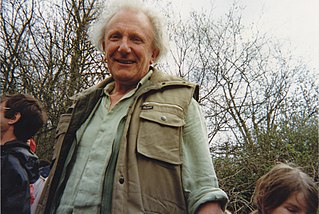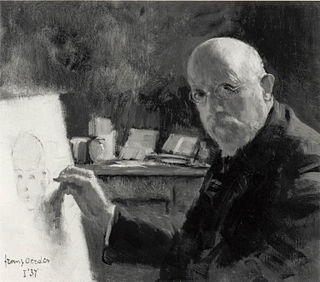
Pretoria is South Africa's administrative capital, serving as the seat of the executive branch of government, and as the host to all foreign embassies to South Africa.
Gerard Sekoto OIG, was a South African artist and musician. He is recognised as a pioneer of urban black art and social realism. His work was exhibited in Paris, Stockholm, Venice, Washington, and Senegal, as well as in South Africa.
Louis Botha Avenue is a major street in Johannesburg, South Africa. Originally part of the main road between central Johannesburg and Pretoria, it runs along through the north-eastern parts of the city from Hillbrow to Sandton, passing through numerous older suburbs, including Houghton and Orange Grove, before it becomes the Pretoria Main Road (R101) which passes the Alexandra Township and continues to Midrand and Pretoria.

Adolph Stephan Friedrich Jentsch was a German-born Namibian artist. He studied at the Dresden Staatsakademie für Bildende Künste for six years, and used a travel grant award to visit France, Italy, UK and the Netherlands. Jentsch moved to Namibia in 1938 to escape the approaching war and lived there until his death. He travelled extensively in Namibia and eventually settled down near Dordabis, about 60 km from the capital Windhoek. He is one of Namibia's most famous painters.

Richard David Shepherd CBE FRSA FGRA was a British artist and one of the world's most outspoken conservationists. He was most famous for his paintings of steam locomotives and wildlife, although he also often painted aircraft, portraits and landscapes. His work has been extremely popular since the 1960s in limited edition print reproduction and poster form, as well as other media such as Wedgwood limited edition plates. He published five books about his art, including an autobiography.

An art manifesto is a public declaration of the intentions, motives, or views of an artist or artistic movement. Manifestos are a standard feature of the various movements in the modernist avant-garde and are still written today. Art manifestos are sometimes in their rhetoric intended for shock value, to achieve a revolutionary effect. They often address wider issues, such as the political system. Typical themes are the need for revolution, freedom and the implied or overtly stated superiority of the writers over the status quo. The manifesto gives a means of expressing, publicising and recording ideas for the artist or art group—even if only one or two people write the words, it is mostly still attributed to the group name.

James Thomson "JT" Bain was a socialist and syndicalist in colonial South Africa.

Judith Mason born Judith Seelander Menge was a South African artist who worked in oil, pencil, printmaking and mixed media. Her work is rich in symbolism and mythology, displaying a rare technical virtuosity.
Bo or Bó as a surname may refer to:
Cyril Fradan (1928–1997) was a South African artist and designer who worked almost exclusively in acrylic paints incorporating various glazing techniques.
Superstroke is a term used for a contemporary art movement with its origins in South Africa. Superstroke is one of the influential art movements regarding African modernism and abstraction. The word "Superstroke" implies the super expressive brush stroke. The Superstroke art movement was initially founded as a reaction to the impact that the Superflat art movement, founded by Takashi Murakami had on modern contemporary art.

Frans David Oerder was a Dutch-born South African landscape, still-life and portrait painter, etcher, and lithographer.
Mbongeni Buthelezi, born 1966 in Johannesburg in South Africa, is an artist who became known for "painting" in plastic.

Esther Mahlangu is a South African artist. She is known for her bold large-scale contemporary paintings that reference her Ndebele heritage. She is one of South Africa's best known artists.

Christo Coetzee was a South African assemblage and Neo-Baroque artist closely associated with the avant-garde art movements of Europe and Japan during the 1950s and 1960s. Under the influence of art theorist Michel Tapié, art dealer Rodolphe Stadler and art collector and photographer Anthony Denney, as well as the Gutai group of Japan, he developed his oeuvre alongside those of artists strongly influenced by Tapié's Un Art Autre (1952), such as Georges Mathieu, Alfred Wols, Jean Dubuffet, Jean Fautrier, Hans Hartung, Pierre Soulages, Antoni Tàpies and Lucio Fontana.
Gordon Froud is a South African artist and curator. Froud's work has been showcased in hundreds of exhibitions throughout South Africa and the world, and he has served as a judge for several national art competitions. He has been the recipient of numerous awards including a Merit Award for Sculpture in the 1988 New Signatures Competition and an ABSA Gold Medal for contribution to the arts in 2005. Froud has also spent many years working as an art educator at both the secondary and tertiary level in London and South Africa. Perhaps known best for his use of found and untraditional materials in his sculptures, Froud attempts to explore the human condition in his work, particularly with regard to DNA, babies, genetics, bacteria, viruses and self-portraits. He currently balances his art practice and curation with running his own Gordart Gallery, which focuses on developing previously little-known artists.
Andries Johannes Botha is an artist and political activist who lives and works in Durban, KwaZulu-Natal, South Africa. He is known for his sculpture.
Walter Edward Westbrook was a South African artist who lived latterly in Kent, England. He was well known particularly for his watercolour landscapes inspired by the arid plains of the Northern Cape and Namibia, and later by the countryside of Kent and the English Channel. Westbrook was born in Pretoria in 1921 and lived in Kimberley for several decades before emigrating to England in the late 1990s. He died in Kent in 2015, aged 93.
Wim Botha is a South African contemporary artist.

Wayne Barker, South African visual artist. Barker is based in Johannesburg. He rose to prominence in the late 80s, at the height of political unrest under the Apartheid regime. His work has featured in several global biennales, art fairs and important retrospective exhibitions. He works in various mediums, including but not limited to painting, printmaking, sculpture, video, performance and installation. In addition to collaborations with other artists, Barker has collaborated with the Qubeka Beadwork Studio based in Cape Town, to realise large scale glass beadworks.









